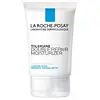What's inside
What's inside
 Key Ingredients
Key Ingredients

 Benefits
Benefits

 Concerns
Concerns

No concerns
 Ingredients Side-by-side
Ingredients Side-by-side

Water
Skin ConditioningCaprylic/Capric Triglyceride
MaskingPanthenol
Skin ConditioningCaprylic/Capric/Succinic Triglyceride
EmollientCaprylyl Caprylate/Caprate
EmollientBetaine
HumectantPentylene Glycol
Skin ConditioningDimethicone
EmollientGlyceryl Stearate Citrate
EmollientGlycerin
HumectantArachidyl Alcohol
EmollientGlyceryl Stearate
EmollientCeramide NP
Skin ConditioningCeramide AP
Skin ConditioningMadecassoside
AntioxidantColloidal Oatmeal
AbsorbentAsiatic Acid
Skin ConditioningMadecassic Acid
Skin ConditioningCeramide EOP
Skin ConditioningCentella Asiatica Leaf Extract
Skin ConditioningAsiaticoside
AntioxidantTasmannia Lanceolata Fruit/Leaf Extract
AntioxidantPhytosphingosine
Skin ConditioningCholesterol
EmollientPolyglyceryl-6 Stearate
EmollientBehenyl Alcohol
EmollientLecithin
EmollientCichorium Intybus Root Extract
MaskingCarbomer
Emulsion StabilisingArachidyl Glucoside
EmulsifyingArginine
MaskingMagnolia Officinalis Bark Extract
AntimicrobialPolyacrylate Crosspolymer-6
Emulsion StabilisingSodium Lauroyl Lactylate
EmulsifyingSodium Hyaluronate
HumectantTocopherol
AntioxidantLeuconostoc/Radish Root Ferment Filtrate
AntimicrobialPolyglyceryl-6 Behenate
Emulsion StabilisingDisodium EDTA
Citric Acid
BufferingPhenoxyethanol
PreservativeXanthan Gum
EmulsifyingEthylhexylglycerin
Skin ConditioningSodium Benzoate
MaskingPotassium Sorbate
PreservativeWater, Caprylic/Capric Triglyceride, Panthenol, Caprylic/Capric/Succinic Triglyceride, Caprylyl Caprylate/Caprate, Betaine, Pentylene Glycol, Dimethicone, Glyceryl Stearate Citrate, Glycerin, Arachidyl Alcohol, Glyceryl Stearate, Ceramide NP, Ceramide AP, Madecassoside, Colloidal Oatmeal, Asiatic Acid, Madecassic Acid, Ceramide EOP, Centella Asiatica Leaf Extract, Asiaticoside, Tasmannia Lanceolata Fruit/Leaf Extract, Phytosphingosine, Cholesterol, Polyglyceryl-6 Stearate, Behenyl Alcohol, Lecithin, Cichorium Intybus Root Extract, Carbomer, Arachidyl Glucoside, Arginine, Magnolia Officinalis Bark Extract, Polyacrylate Crosspolymer-6, Sodium Lauroyl Lactylate, Sodium Hyaluronate, Tocopherol, Leuconostoc/Radish Root Ferment Filtrate, Polyglyceryl-6 Behenate, Disodium EDTA, Citric Acid, Phenoxyethanol, Xanthan Gum, Ethylhexylglycerin, Sodium Benzoate, Potassium Sorbate
Water
Skin ConditioningGlycerin
HumectantSqualane
EmollientDimethicone
EmollientZea Mays Starch
AbsorbentNiacinamide
SmoothingAmmonium Polyacryloyldimethyl Taurate
Emulsion StabilisingMyristyl Myristate
EmollientStearic Acid
CleansingCeramide NP
Skin ConditioningPotassium Cetyl Phosphate
EmulsifyingGlyceryl Stearate Se
EmulsifyingSodium Hydroxide
BufferingMyristic Acid
CleansingPalmitic Acid
EmollientCapryloyl Glycine
CleansingCaprylyl Glycol
EmollientXanthan Gum
EmulsifyingWater, Glycerin, Squalane, Dimethicone, Zea Mays Starch, Niacinamide, Ammonium Polyacryloyldimethyl Taurate, Myristyl Myristate, Stearic Acid, Ceramide NP, Potassium Cetyl Phosphate, Glyceryl Stearate Se, Sodium Hydroxide, Myristic Acid, Palmitic Acid, Capryloyl Glycine, Caprylyl Glycol, Xanthan Gum
 Reviews
Reviews

Ingredients Explained
These ingredients are found in both products.
Ingredients higher up in an ingredient list are typically present in a larger amount.
Ceramide NP is a type of ceramide and formally known as ceramide 3.
Ceramides are intercellular lipids naturally found in our skin that bonds dead skin cells together to create a barrier. They are known for their ability to hold water and thus are a great ingredient for dry skin.
Ceramides are an important building block for our skin barrier. A stronger barrier helps the skin look more firm and hydrated. By bolstering the skin ceramides act as a barrier against irritating ingredients. This can help with inflammation as well.
If you would like to eat ceramides, sweet potatoes contain a small amount.
Read more about other common types of ceramides here:
Ceramide AP
Ceramide EOP
Dimethicone is a type of synthetic silicone created from natural materials such as quartz.
What it does:
Dimethicone comes in different viscosities:
Depending on the viscosity, dimethicone has different properties.
Ingredients lists don't always show which type is used, so we recommend reaching out to the brand if you have questions about the viscosity.
This ingredient is unlikely to cause irritation because it does not get absorbed into skin. However, people with silicone allergies should be careful about using this ingredient.
Note: Dimethicone may contribute to pilling. This is because it is not oil or water soluble, so pilling may occur when layered with products. When mixed with heavy oils in a formula, the outcome is also quite greasy.
Learn more about DimethiconeGlycerin is already naturally found in your skin. It helps moisturize and protect your skin.
A study from 2016 found glycerin to be more effective as a humectant than AHAs and hyaluronic acid.
As a humectant, it helps the skin stay hydrated by pulling moisture to your skin. The low molecular weight of glycerin allows it to pull moisture into the deeper layers of your skin.
Hydrated skin improves your skin barrier; Your skin barrier helps protect against irritants and bacteria.
Glycerin has also been found to have antimicrobial and antiviral properties. Due to these properties, glycerin is often used in wound and burn treatments.
In cosmetics, glycerin is usually derived from plants such as soybean or palm. However, it can also be sourced from animals, such as tallow or animal fat.
This ingredient is organic, colorless, odorless, and non-toxic.
Glycerin is the name for this ingredient in American English. British English uses Glycerol/Glycerine.
Learn more about GlycerinWater. It's the most common cosmetic ingredient of all. You'll usually see it at the top of ingredient lists, meaning that it makes up the largest part of the product.
So why is it so popular? Water most often acts as a solvent - this means that it helps dissolve other ingredients into the formulation.
You'll also recognize water as that liquid we all need to stay alive. If you see this, drink a glass of water. Stay hydrated!
Learn more about WaterXanthan gum is used as a stabilizer and thickener within cosmetic products. It helps give products a sticky, thick feeling - preventing them from being too runny.
On the technical side of things, xanthan gum is a polysaccharide - a combination consisting of multiple sugar molecules bonded together.
Xanthan gum is a pretty common and great ingredient. It is a natural, non-toxic, non-irritating ingredient that is also commonly used in food products.
Learn more about Xanthan Gum